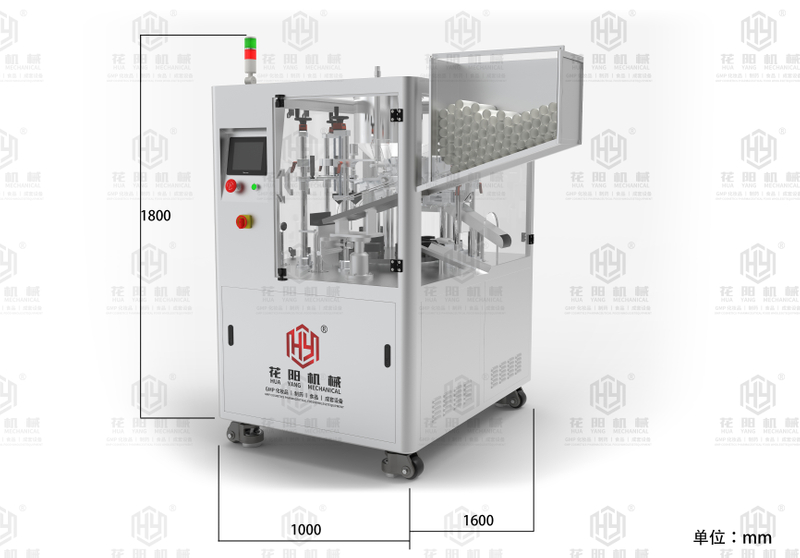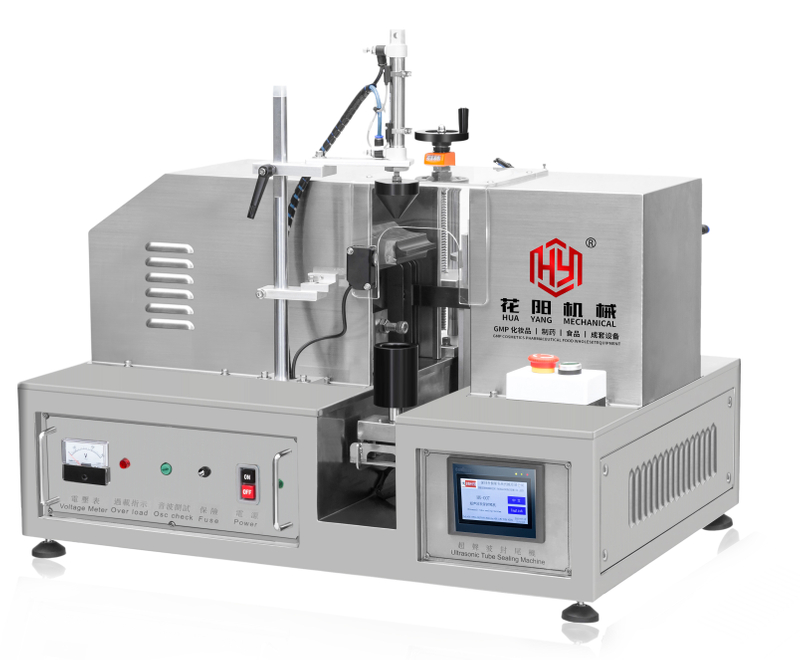T: +86-20-36204500
No. 3, Lane 3, Junmin East Road, Hebian, Baiyun District, Guangzhou








Did you know that the right toothpaste can significantly improve your oral health? Understanding how to make toothpaste is essential for maintaining good hygiene.
In this article, we’ll explore the key ingredients and the process involved in making toothpaste. You’ll also learn about the crucial role of tube sealing machines in ensuring product quality and safety.

Toothpaste is a gel or paste used to clean teeth. Its primary purpose is to remove food particles and reduce plaque buildup. Regular use helps prevent cavities and promotes overall oral health.
Toothpaste typically contains several key ingredients:
● Fluoride: Strengthens tooth enamel and helps prevent decay.
● Abrasives: Ingredients like calcium carbonate or silica help scrub away stains.
● Humectants: Glycerin or sorbitol keeps toothpaste moist and prevents it from drying out.
● Flavoring Agents: These make toothpaste more palatable, with options ranging from mint to fruit flavors.
● Thickening Agents: Xanthan gum or carboxymethyl cellulose gives toothpaste its desired consistency.
There are various types of toothpaste tailored for specific needs:
● Whitening Toothpaste: Contains special abrasives or chemicals to remove stains.
● Fluoride Toothpaste: Designed to provide additional cavity protection.
● Herbal Toothpaste: Made from natural ingredients, appealing to those seeking chemical-free options.
● Sensitivity Toothpaste: Formulated to help reduce tooth sensitivity.
Tube sealing machines play a crucial role in toothpaste production. They are used to seal the tubes that hold the toothpaste, ensuring that the product remains fresh and uncontaminated.
These machines guarantee product quality and shelf life in several ways:
● Sealing Integrity: They create airtight seals, preventing leaks and contamination.
● Consistency: Each tube is sealed uniformly, maintaining quality standards across batches.
● Hygiene: Automated sealing reduces human contact, minimizing contamination risks.
Using tube sealing machines offers numerous advantages for manufacturers:
● Efficiency: They speed up the packaging process, allowing for higher production rates.
● Cost-Effectiveness: Reduced labor costs and minimized product waste lead to savings.
● Flexibility: Many machines can handle various tube sizes and materials.
When selecting a tube sealing machine, consider these competitive features:
● Rapid Changeover Capabilities: Quick adjustments for different tube sizes enhance productivity.
● Built-in Air Compressors: These ensure optimal sealing pressure, improving seal quality.
● User-Friendly Interfaces: Easy operation reduces training time and improves workflow.
In summary, understanding toothpaste production involves knowing its ingredients and the vital role of tube sealing machines. These machines not only enhance quality but also streamline the manufacturing process.
When making toothpaste, several essential ingredients are necessary for effectiveness and safety. Here’s a closer look at these components:
Fluoride is a key ingredient in many toothpaste formulations. It helps strengthen tooth enamel and reduces the risk of cavities.
● Benefits:
○ Remineralizes early decay.
○ Provides protection against acid attacks from bacteria.
● Sources:
○ Naturally found in water supplies.
○ Added to many commercial toothpaste brands.
Abrasives play a vital role in removing plaque and stains from teeth. Here are some common types:
● Calcium Carbonate: A mild abrasive that helps clean teeth and polish enamel.
● Silica: A gentle abrasive that effectively removes stains without damaging enamel.
Humectants are crucial for keeping toothpaste moist and preventing it from drying out. They also improve texture. Common examples include:
● Glycerin: Adds moisture and sweetness.
● Sorbitol: Helps maintain consistency and moisture.
Flavoring agents make toothpaste more palatable. They can be natural or artificial:
● Natural Flavors: Derived from plants, like mint or cinnamon.
● Artificial Flavors: Synthetically created to mimic various tastes.
Thickening agents ensure toothpaste has the right consistency. They help it stay in the tube and provide a pleasant texture.
● Xanthan Gum: A popular thickener that stabilizes the formulation.
If you want to personalize your toothpaste, consider these optional ingredients:
Many people prefer natural alternatives for their toothpaste. Some popular options include:
● Baking Soda: Acts as a mild abrasive and whitener.
● Coconut Oil: Known for its antibacterial properties and smooth texture.
● Essential Oils: Such as peppermint or tea tree oil for added flavor and benefits.
Colorants can enhance the visual appeal of toothpaste. Here’s a breakdown:
● Natural Colorants: Derived from plants, like beet juice for a red tint.
● Synthetic Colorants: Chemically produced dyes, often used for vibrant colors.
These ingredients combine to create effective, safe, and appealing toothpaste. Each component has its unique role, contributing to overall oral health.
Making toothpaste at home can be a fun and rewarding project. Here’s a detailed guide to help you through the process.
Before starting, gather all necessary materials and tools. Here’s a checklist:
● Ingredients:
○ Fluoride (if desired)
○ Abrasives (e.g., calcium carbonate, silica)
○ Humectants (e.g., glycerin, sorbitol)
○ Flavoring agents (natural or artificial)
○ Thickening agents (e.g., xanthan gum)
● Tools:
○ Mixing bowl
○ Spoon or spatula
○ Measuring cups and spoons
○ Storage containers or tubes
Once you have everything ready, it’s time to mix the ingredients. Follow these steps:
1. Combine Dry Ingredients: Start by mixing abrasives and thickening agents in a bowl.
2. Add Liquid Ingredients: Slowly incorporate humectants and flavoring agents.
3. Stir Thoroughly: Use a spatula to ensure everything is well blended.
Importance of Ratios and Consistency:
Maintaining the right ratios is crucial. Too much abrasive can make it gritty, while too little can reduce effectiveness. Aim for a smooth, paste-like consistency.
After mixing, it’s important to test the texture and taste:
● Texture Adjustments: If it’s too thick, add a bit more glycerin. If too runny, add more thickening agent.
● Flavor Adjustments: Taste your mixture. If it’s not flavorful enough, add more flavoring agent gradually.
Proper packaging is essential for maintaining freshness and hygiene. Here’s how to do it:
● Choose Appropriate Containers: Use clean, airtight tubes or jars to store your toothpaste.
● Fill Containers Carefully: Ensure no air bubbles are trapped inside.
Tube sealing machines are vital in the final packaging stage. They ensure that each tube is sealed tightly to prevent leakage and contamination.
● Sealing Process: The machine applies heat or pressure to seal the tube securely.
When it comes to toothpaste production, there are two main types of tube sealing machines:
● Semi-Automatic Machines: Require some manual input but are cost-effective for smaller batches.
● Fully Automatic Machines: Ideal for large-scale production, these machines handle everything from filling to sealing.
Modern tube sealing machines offer several advantages:
● Thermal Impulse Sealing: Provides a strong, reliable seal.
● Ultrasonic Sealing: Ensures a clean and efficient sealing process.
Many tube sealing machines come equipped with additional features, enhancing their utility:
● Date and Lot Coding: These functions allow for traceability, crucial for quality control and safety.
By following this process, you can create your own toothpaste while understanding the importance of packaging and sealing technologies.
Quality control is essential in toothpaste manufacturing. It ensures that the final product is safe and effective for consumers. Here’s a closer look at its importance:
● Importance of Quality Control:Guarantees safety for users.
○ Ensures efficacy in preventing cavities and promoting oral health.
Tube sealing machines play a crucial role in maintaining hygiene and preventing contamination during production:
● Preventing Contamination: These machines seal toothpaste tubes tightly, reducing the risk of bacteria entering the product.
● Hygiene Maintenance: They operate in clean environments, ensuring that products remain uncontaminated.
Several quality control measures are standard in toothpaste production:
1. Ingredient Testing: All raw materials should be tested for purity and safety.
2. In-Process Inspections: Regular checks during production help catch any issues early.
3. Final Product Testing: Each batch is tested for consistency, flavor, and safety.
Clean Room Compatibility:
Many tube sealing machines are designed for clean room environments, meeting stringent hygiene standards. This compatibility is crucial for preventing contamination.
Toothpaste production is governed by various regulations to ensure safety and quality:
● Overview of Regulations:
○ Organizations like the FDA (Food and Drug Administration) in the U.S. set strict guidelines for toothpaste ingredients and labeling.
○ Manufacturers must adhere to these regulations to ensure consumer safety.
● Importance of Compliance:
○ Compliance protects consumers from harmful ingredients.
○ It enhances the manufacturer’s credibility and marketability.
By implementing robust quality control measures and adhering to regulations, manufacturers can produce safe, effective toothpaste that consumers trust.

When we think about toothpaste, we often overlook its environmental footprint. However, the production process can significantly impact our planet. To address this, many manufacturers are now focusing on eco-friendly ingredients and packaging.
● Eco-Friendly Ingredients:
○ Natural alternatives like baking soda and coconut oil are gaining popularity. These ingredients not only clean effectively but also reduce chemical waste.
○ Fluoride, while beneficial for dental health, raises concerns about environmental contamination. Some brands are exploring fluoride-free options.
● Packaging:
○ Traditional toothpaste tubes are often made from non-recyclable materials. In response, brands are innovating with biodegradable packaging.
○ For example, some companies now use plant-based plastics that break down more easily in landfills.
Aspect | Traditional Toothpaste | Natural Toothpaste |
Ingredients | Synthetic chemicals | Natural, organic |
Packaging | Non-recyclable tubes | Biodegradable options |
Carbon footprint | Higher | Lower |
Water usage in production | More | Less |
The table above highlights the differences between traditional and natural toothpaste. As you can see, natural options tend to be more environmentally friendly, reducing waste and resource consumption.
Recent innovations are transforming how toothpaste is packaged. Manufacturers are now developing:
● Biodegradable tubes: Made from materials that decompose naturally.
● Refillable containers: Allow consumers to buy toothpaste refills, minimizing waste.
● Smart packaging: Some companies are integrating QR codes that educate consumers on recycling practices.
These advancements not only help the environment but also appeal to eco-conscious consumers.
Consumers play a vital role in promoting sustainability. By choosing eco-friendly products, you can make a significant impact. Here are a few tips:
● Look for certifications: Products labeled as organic or eco-friendly often meet higher environmental standards.
● Research brands: Support companies that prioritize sustainability in their practices.
● Spread the word: Share your findings with friends and family to encourage more sustainable choices.
Manufacturers are stepping up to the plate. They have the power to influence consumer habits by:
● Investing in sustainable practices: This includes sourcing ingredients responsibly and reducing waste in production.
● Educating consumers: Many brands are now providing information on their websites about their sustainability efforts.
● Collaborating with environmental organizations: Partnerships can drive change and promote broader awareness of ecological issues.
By working together, consumers and manufacturers can create a more sustainable future for toothpaste production.
Toothpaste is essential for oral health. Tube sealing machines are vital in ensuring its safety and effectiveness during production.
We encourage readers to try making their own toothpaste at home. Understanding the production process can lead to better choices and healthier options. Embrace the benefits of knowing how your toothpaste is made!
A: Yes, you can make toothpaste at home using simple ingredients like baking soda, coconut oil, and essential oils.
A: Natural ingredients can be gentler on your teeth and gums, reduce chemical exposure, and promote overall oral health.
A: Tube sealing machines ensure airtight seals, preventing contamination and maintaining hygiene during production.
A: Consider production capacity, type (semi-automatic or fully automatic), and features like coding for traceability.